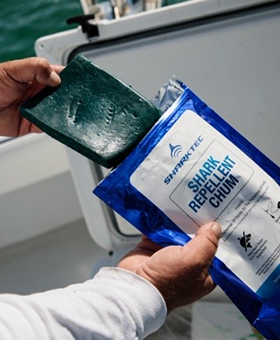Shark Repellent Research Guide
Government Agency NOAA endorses shark repellent in a report to Congress.
- A government biologist working at NOAA has stated that our scientist partners deserve credit for developing a chemical shark repellent that works.
- Read more details (pages 43-50): NOAA Report
- Reported by: The Washington Post
- Reported by: Florida Keys News
Our scientists used the semiochemicals in our product to reduce shark by-catch by 71% in a government grant initiative.
- Scientists estimated that if our semiochemicals are applied globally then 4,258,080 – 8,279,600 sharks a year will be saved.
- The world wide environmental impact potential is highlighted in this infograph
- An Agency under the U.S. Department of Commerce released these findings in a report to Congress: NOAA Study Findings
Verified field testing on numerous shark species.
- 15 species have proven to be effectively repelled by the semiochemicals in SharkTec’s product.
- Reported by: C&E Article
- Reported by: National Geographic
- University of Miami oversaw study.
A 5 year study concluded consistent, effective shark repellent results.
- A 5 year field trial on SharkTec’s technology proved to repel 2 species of sharks 100% of the time within 1 minute of local dispersion of our product.
- The findings were published in the scientific journal Ocean & Coastal Management.
- Seton Hall University contributed to the study.
- Published Findings: Ocean & Coastal Management Journal
Chemical repellents may be more effective than magnetic or electrical repellents.
- A study concluded chemical signals travel much further than mechanical or electrical signals.
- Olfaction is considered especially important as a distant sense because chemical signals can become entrained in currents and transported much farther in the marine environment than mechanical or electrical signals (Hueter et al., 2004).
- Reported By: http://www.science.fau.edu/sharklab/pdfs/mk10b.pdf
Shark species are chemically aware of its dead and will avoid odors that replicate this awareness.
- Published in the Canadian Journal of Fisheries and Aquatic Sciences: http://www.nrcresearchpress.com/doi/full/10.1139/f2011-072#.VrV5KLIrKUk
- Michigan State University conducted study and provided Grant.
- Great Lakes Fishery Commission endorsed study.
Supporting Research
Commercial fishermen have long reported that shark fishing dramatically decreased in areas where decomposing shark tissue was present.
- Published in Military Medicine, a peer-reviewed international journal.
- Read More: https://www.researchgate.net/publication/21037050_Shark_repellent_Not_yet_maybe_never
Semiochemicals found in the bodily secretions of predators may convey survival information to a shark and elicit rapid flight from an area that is potentially dangerous.
- Study conducted by the Department of Biological Sciences, California State University.
- Published in Environmental Biology of Fishes international scientific journal.
- Read More: https://www.researchgate.net/publication/263688098_Surfactants_as_Chemical_Shark_Repellents_Past_Present_and_Future
Semiochemicals exist in extremely low concentrations within decaying shark flesh and act as alarm substances for other sharks in the proximity.
- Source: Rasmussen, L.E.L., Schmidt, M.J., 1992. Are sharks chemically aware of crocodiles? In: Doty, R.L., Müller-Schwarze, D. (Eds.), Chemical Signals in Vertebrates IV. Plenum Press, New York, pp. 335e342.
The findings from this study suggested that sharks may be chemically aware of the presence of potential danger through the sensing of bodily secretions from predators.
- Source: Sisneros, J.A., Nelson, D.R., 2001. Surfactants as chemical shark repellents: past, present, and future. Environmental Biology of Fishes 60, 117e129
Grants and Funding
- Federal Funding Grant to develop technology.
- Source (pg.15-16): http://www.fisheries.noaa.gov/mb/sk/pdf/sk2010_report.pdf
- NOAA Bycatch Reduction and Engineering Program (BREP).
- Grant Details can be found at NOAA's Grant Awards
- Great Lakes Fishery Commission. Development of a Putrefaction-Derived Repellent for the Sea Lamprey.
- National Science Foundation. Small Business Innovative Research Phase 1B Award (SBIR). “Multifunctional Hook Material for Commercial Fisheries”.
- Michigan State University, Center for Water Sciences Venture Grant. “Preliminary identification of a putrefaction-derived repellent for the invasive sea lamprey (Petromyzon marinus)”.
- Saltonstall-Kennedy Grant Program, FY 2009. “Process for Converting Shark Discards into a Shark Bycatch Reduction Technology”.
- NOAA PIFSC/JIMAR, Hawaii. Chemical repellents as a means to reduce shark bycatch in commercial longlines.
- NOAA PIFSC/JIMAR, Hawaii. Equipment/capital grant for chemical repellent research.


